The national park protects five of the islands, and visiting any of them requires booking a boat ride through a concessionaire. We’d booked a trip with a company called Island Packers to Santa Cruz Island, the largest island in California at 96 square miles in area and 24 miles long. Only the easternmost 24% of the island is actually part of the national park – the western 76% is owned by the Nature Conservancy and protected separately. On Monday, we were going to be dropped off at Prisoners Harbor at the west end of the national park land, and on Wednesday, we’d be picked up at Scorpion Anchorage at the east end of the island. In between, we’d camp for two nights on the island and hike 14 miles.
A little ways off the coast, it was warm, but as we boarded the boat in Ventura, the sea breeze was a bit chilly.

As the boat headed out to see, we both put on our fleece hats and rain jackets to ward off the cold and wind.
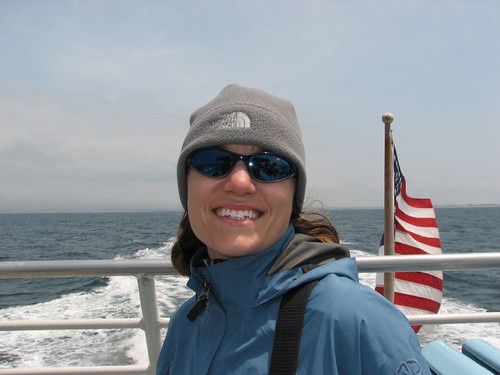
It took an hour to get from Ventura to the eastern end of Santa Cruz. About halfway through the journey, we passed a set of offshore oil rigs, which the captain said marked the edge of an underwater canyon where the water depth dropped dramatically. He said that we should watch out for wildlife in this area. We’d passed the oil rigs when someone shouted about a whale, and the boat stopped. All of the passengers rushed to the front of the boat, and sure enough, there was a humpback whale near the surface!
We found ourselves a place right at the front of the lower deck of the boat in time to see the whale’s tail come out of the water as it dove down in search of food. The tail was huge! A bit later, we found out from the captain that this was just a juvenile whale. We can’t imagine how big a full-grown humpback would be! The whale stayed down for about four minutes before coming to the surface again. We watched for a while before the boat sped up again toward Santa Cruz.
The boat landed at Scorpion Anchorage, and nearly all of the passengers disembarked. We stayed on the boat with four other passengers to head to Prisoners Harbor at the less-developed western end of the national park property.
Along the way, we got some nice views of the island. The shore of the island was very rugged, with lots of sheer cliffs dropping straight down to the water. Occasionally, a sea cave cut into the base of a cliff.
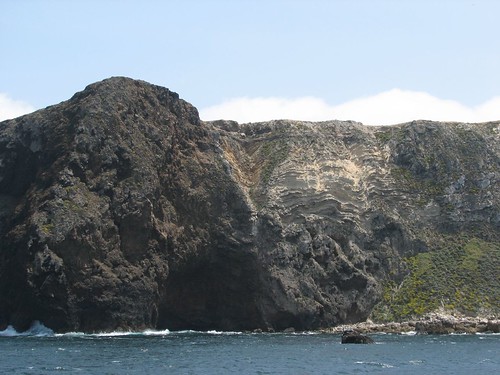
A short while later, we arrived at the rocky beach of Prisoners Harbor.
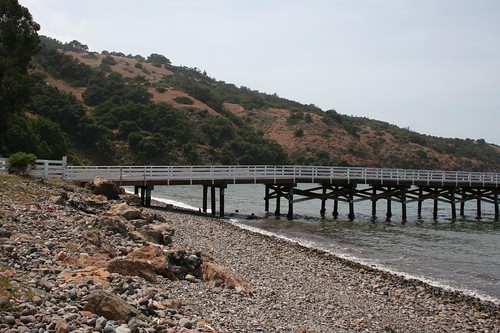
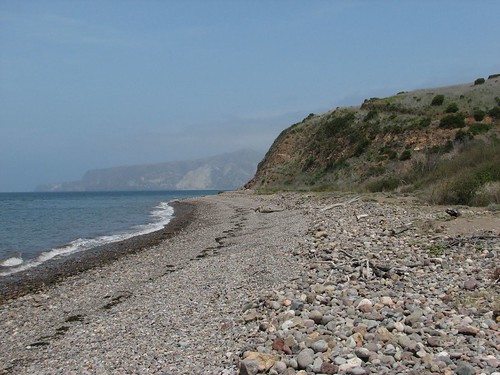
It was about 2:30, so we ate a late lunch before heading out toward our night’s campsite at the Del Norte Camp. As we climbed up from the ocean, we took one last look back at the harbor and our boat.
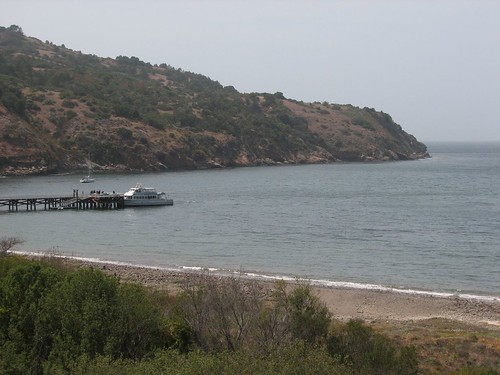
It’s not just the coastline of Santa Cruz Island that’s rocky. The island has two mountain ranges, which reach up to 2450 feet and are separated by a central valley. Tonight’s campsite was a 3.5-mile hike from the harbor and about 700 feet up. The hike was uneventful, occasionally offering pretty views of the ocean.
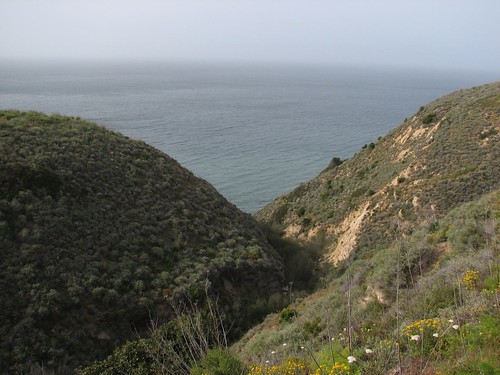
For most of the hike, the trail traveled through grasslands, with the trail being simply a mowed path through the grass. The campground, likewise, was simply a large area that had been mowed out of the grass, with four picnic tables and an outhouse. But oh, the views! We had a gorgeous view of the ocean to the north and the island’s mountains to the west, which made for an incredible sunset.
It started out orange:
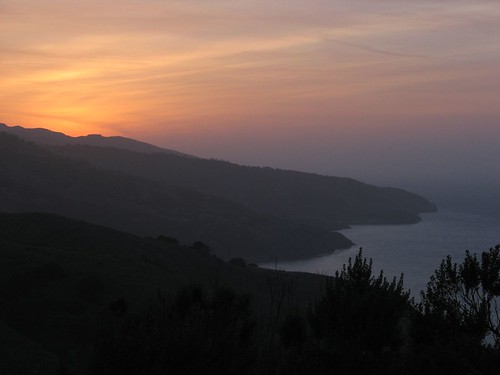
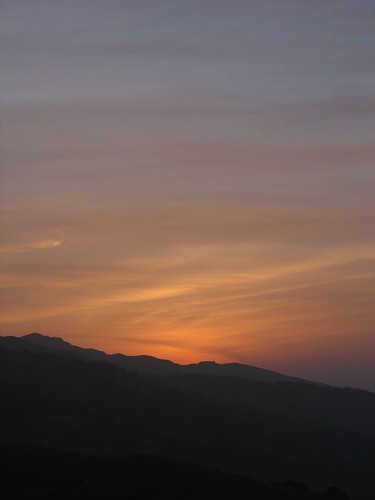
That was pretty enough, but after the sun was all the way, the orange gave way to pinks and purples, which looked even more amazing:
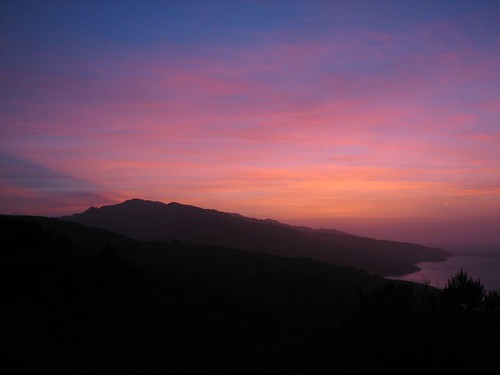
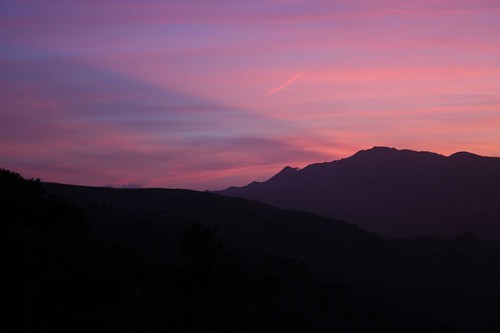
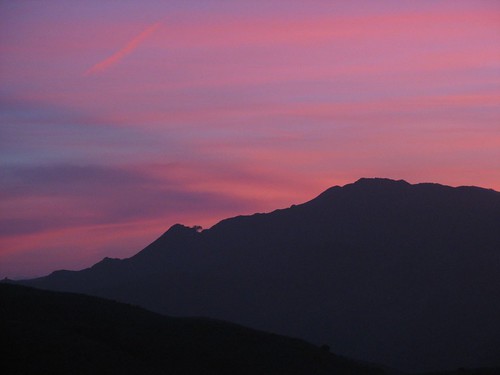
The next day, we got an early start because we had 12 miles to hike to the Scorpion Campground, where we’d spend the next night. The Scorpion Campground is only a half mile from the Scorpion Anchorage, where most passengers get off the boat, so it’s a lot more popular than the Del Norte Camp.
The hike was quite beautiful, with frequent awesome ocean views, but the highlight was the wildlife viewing. Brian was hiking along, lost in his thoughts, when Sarah whispered loudly at him to stop. He did and she pointed out an island fox on the trail right in front of us! It was much smaller than the red foxes we’d seen, and it was more of a dark gray color, with ears that seemed too big for its head. It stared at us while we stared back, clearly equally surprised to see each other. As we reached for our cameras, it bounded off into the brush beside the trail. We caught sight of it after it had stopped again to look at us, and then it was off.
The island foxes, native to the Channel Islands, were nearly driven to extinction, in a story that emphasizes the interconnectedness of the ecosystem. The fox population dropped precipitously in the 1990s due to predation by golden eagles, which aren’t native to the islands. They arrived for two reasons: First, many years of human occupation of the islands resulted in sizable feral pig populations, and little piglets are a tasty treat for golden eagles. Second, the islands’ bald eagle population was eliminated by DDT. The elimination of the territorial bald eagles made space for the golden eagles, who ate the piglets and also baby foxes.
Over the past decade, golden eagles have been captured on the islands and then released on the mainland so that in 2007 only one remained on the islands. Also, the feral pigs have been removed and bald eagles have been reintroduced, so the conditions that allowed golden eagles to thrive have been eliminated. Finally, island foxes have been bred in captivity and then reintroduced to the islands. Now the island fox population on Santa Cruz Island alone is thought to be over 300, and we were lucky enough to see one of the little guys on our hike.
Shortly after we saw the fox, we got to see a bald eagle soaring overhead.
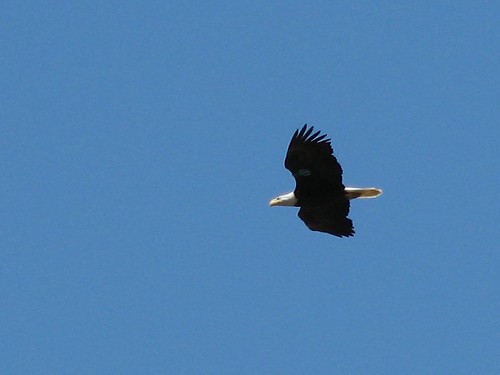
Aside from the wildlife, we just had one amazing ocean view after another.

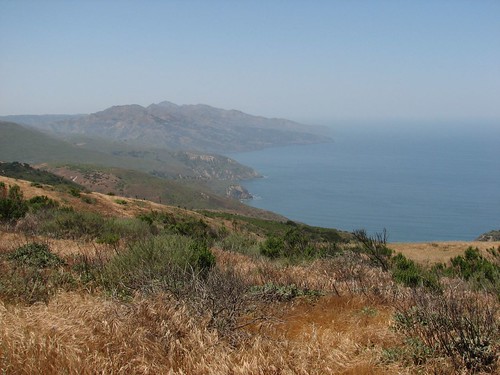
After a while, Anacapa Island, the easternmost of the Channel Islands in the park, came into view.

The trail was tough to follow in places, and where the trail up to Montañon Ridge, splits off, we almost lost it. But Sarah noticed a sign off in the grass and followed a faint path until it turned into a real trail. Here’s Sarah with Montañon Ridge in the background:

It was a steep climb up one spine that stretched down from the main ridgeline. As we climbed, we got better views of the ridge.

Finally, we reached the top and started down to our campground, with more great views of the ocean and Anacapa Island ahead.
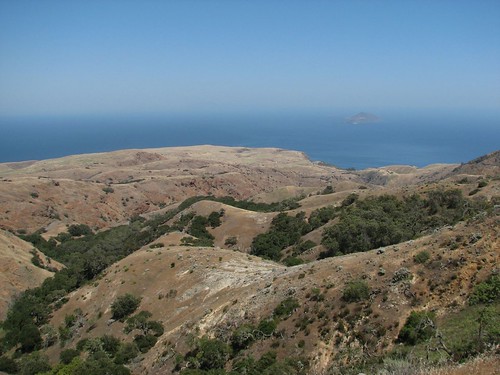
Scorpion Campground is separated into two sections. The upper campground is in Scorpion Canyon and consists mostly of group sites, while the lower campground is closer to the ocean. We’d reserved a site in the lower campground, thinking that we didn’t want to be near the group sites. Our trail took us through the upper campground first, though, and it was in a beautiful setting and completely empty, so we decided to take a site there instead. Here’s the view up the canyon from our campsite:

The campground was full of eucalyptus trees, which dropped these curious-looking pyramidal acorn-like objects frequently on our campsite. We set up camp with a couple of hours before dark and no one else showed up, so for a second night in a row, we had our campground to ourselves. We imagined that the lower campground was probably busy and were happy that we had chanced upon the empty upper campground.
The next day, we had time to explore. We were just a mile away from the Scorpion Anchorage, and our boat didn’t leave there until 3 p.m., so instead of heading directly there, we hiked toward Potato Harbor. After hiking out of Scorpion Canyon, the trail took us along a bluff over the ocean, with fantastic views.
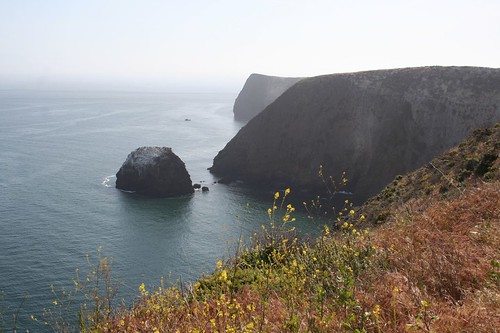
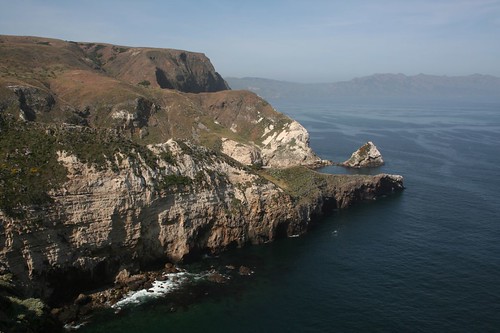
As we reached the overlook for Potato Harbor, we found an eggshell on the ground.
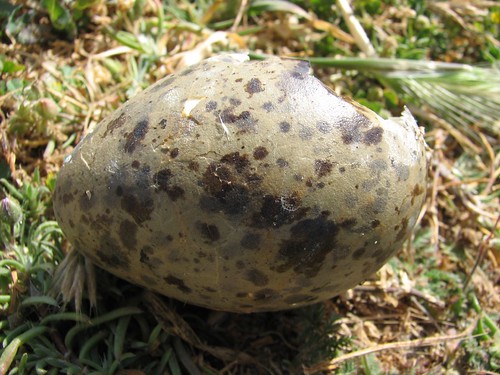
It was pretty big – maybe three inches long. We later saw a pelican egg in a visitors center that was the same shape, but we’re not sure if that’s what it was.
We sat down at the overlook and hung out for about an hour.

In the time we were there, we saw dozens of pelicans, some flying high up in the sky, and others skimming just above the water.
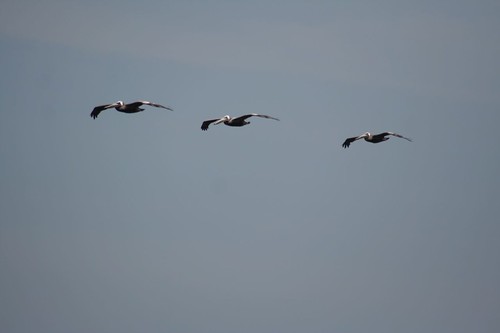

With our binoculars, we were also able to see eight sea lions! When we first arrived, we only saw one lying out on the rocks. It was so still that it looked like a log, but a bit shinier. But as we kept looking around, we saw more of them playing around in the water, and over time, seven more dragged themselves up out of the water and lay out in the sun.
Eventually, we got up and headed back along the bluff toward Scorpion Anchorage. We ran into a ranger-led hike, the first people we had seen in 44 hours! We also visited the lower campground and found it empty – as far as we could tell, we had been the only campers on the island the previous night! The lower campground was also full of beautiful, lovely-smelling eucalyptus trees.
We got to the anchorage a bit early, so we walked along the rocky shoreline to look for tidepool life. We saw a couple of big starfish, orange and purple. There were also little crabs everywhere – every time we took a step, we’d see crabs scattering and hiding under rocks. After Brian stayed very still, a couple came back out:

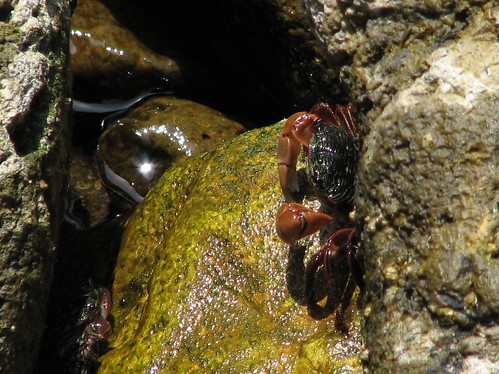
The anchorage was also full of pelicans.

Just before 3:00, we hopped back on the boat for our ride back. We kept our eyes peeled for whales, but we only saw four sea lions swimming along. That would have been pretty exciting on the way out, but the fact that it was anticlimactic now was a good indication of what great wildlife viewing we’d had on the trip! As we got back to the mainland, we saw some more pelicans hanging out on the rocks.

That afternoon, we ran some errands and then headed up the coast a little ways on the Pacific Coast Highway. We stayed at Hobson State Beach, an unexciting but functional parking lot on the coast. The campsites were small, but the sound of crashing waves near our tent was soothing, and the campground had coin-operated showers, which were very welcome after our time in the backcountry.
Tomorrow, we would continue up the California coast!
No comments:
Post a Comment